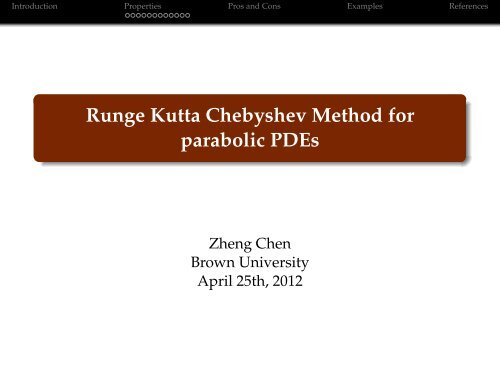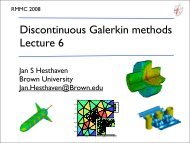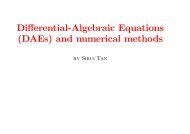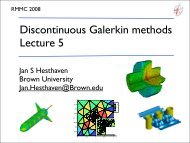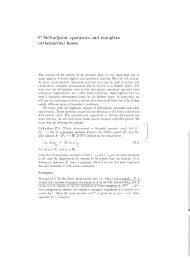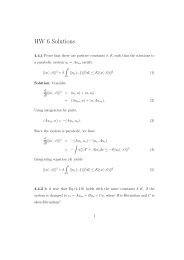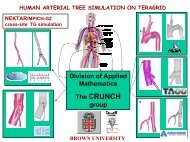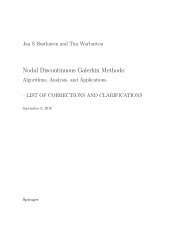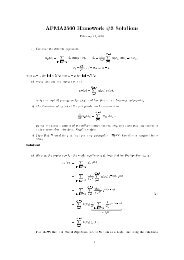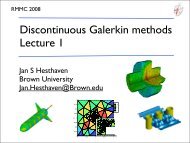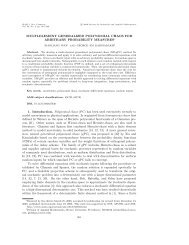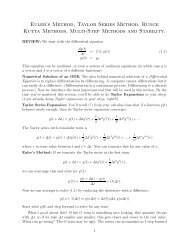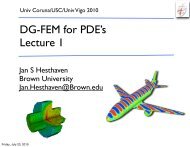Runge Kutta Chebyshev Method for parabolic ... - Brown University
Runge Kutta Chebyshev Method for parabolic ... - Brown University
Runge Kutta Chebyshev Method for parabolic ... - Brown University
Create successful ePaper yourself
Turn your PDF publications into a flip-book with our unique Google optimized e-Paper software.
Introduction Properties Pros and Cons Examples References<br />
<strong>Runge</strong> <strong>Kutta</strong> <strong>Chebyshev</strong> <strong>Method</strong> <strong>for</strong><br />
<strong>parabolic</strong> PDEs<br />
Zheng Chen<br />
<strong>Brown</strong> <strong>University</strong><br />
April 25th, 2012
Introduction Properties Pros and Cons Examples References<br />
Overview<br />
1 Introduction<br />
2 Properties<br />
Consistency conditions<br />
Stability Properties<br />
Integration <strong>for</strong>mula<br />
3 Pros and Cons<br />
4 Examples<br />
5 References
Introduction Properties Pros and Cons Examples References<br />
Introduction<br />
initial value problem <strong>for</strong> the ODE systems:<br />
˙u(t) = F(t, u(t)), 0 < t � T, u(0) = u0<br />
which originate from spatial discretization of <strong>parabolic</strong> PDEs.<br />
Restrictions:<br />
The eigenvalues of the Jacobian matrix should lie in a<br />
narrow strip along the negative axis of the complex plane<br />
Example:<br />
(1)
Introduction Properties Pros and Cons Examples References<br />
Introduction<br />
initial value problem <strong>for</strong> the ODE systems:<br />
˙u(t) = F(t, u(t)), 0 < t � T, u(0) = u0<br />
which originate from spatial discretization of <strong>parabolic</strong> PDEs.<br />
Restrictions:<br />
The eigenvalues of the Jacobian matrix should lie in a<br />
narrow strip along the negative axis of the complex plane<br />
Jacobian matrix should not deviate too much from a<br />
normal matrix.<br />
Example:<br />
(1)
Introduction Properties Pros and Cons Examples References<br />
Introduction<br />
initial value problem <strong>for</strong> the ODE systems:<br />
˙u(t) = F(t, u(t)), 0 < t � T, u(0) = u0<br />
which originate from spatial discretization of <strong>parabolic</strong> PDEs.<br />
Restrictions:<br />
The eigenvalues of the Jacobian matrix should lie in a<br />
narrow strip along the negative axis of the complex plane<br />
Jacobian matrix should not deviate too much from a<br />
normal matrix.<br />
Example:<br />
model heat equation<br />
(1)<br />
˙u(t) = ∆u (2)
Introduction Properties Pros and Cons Examples References<br />
Introduction<br />
initial value problem <strong>for</strong> the ODE systems:<br />
˙u(t) = F(t, u(t)), 0 < t � T, u(0) = u0<br />
which originate from spatial discretization of <strong>parabolic</strong> PDEs.<br />
Restrictions:<br />
The eigenvalues of the Jacobian matrix should lie in a<br />
narrow strip along the negative axis of the complex plane<br />
Jacobian matrix should not deviate too much from a<br />
normal matrix.<br />
Example:<br />
model heat equation<br />
reaction-diffusion problem<br />
(1)<br />
˙u(t) = ∆u (2)<br />
˙u(t) = ɛ∆u + f(u, x, t), 0 < ɛ ≪ 1 (3)
Introduction Properties Pros and Cons Examples References<br />
Introduction<br />
Stiff problems:<br />
standard explicit RK methods:<br />
easy application, restrictive time-step <strong>for</strong> stability
Introduction Properties Pros and Cons Examples References<br />
Introduction<br />
Stiff problems:<br />
standard explicit RK methods:<br />
easy application, restrictive time-step <strong>for</strong> stability<br />
implicit RK methods:<br />
expensive to implement, unconditionally stable
Introduction Properties Pros and Cons Examples References<br />
Introduction<br />
Stiff problems:<br />
standard explicit RK methods:<br />
easy application, restrictive time-step <strong>for</strong> stability<br />
implicit RK methods:<br />
expensive to implement, unconditionally stable<br />
RKC methods:<br />
explicit, considerable time-step restriction<br />
extended real stability interval with a length β ∝ s 2
Introduction Properties Pros and Cons Examples References<br />
RKC <strong>for</strong>mula<br />
Y0 = Un, (4)<br />
Y1 = Y0 + ˜µ1τF0, (5)<br />
Yj = µjYj−1 + νjYj−2 + (1 − µj − νj)Y0<br />
(6)<br />
+ ˜µjτFj−1 + ˜γjτF0 (2 � j � s), (7)<br />
Un+1 = Ys, n = 0, 1, . . . , (8)<br />
This can be rewritten in the standard RK <strong>for</strong>m:<br />
�j−1<br />
Yj = Un + τ<br />
l=0<br />
ajlF(tn + clτ, Yl), (0 � j � s) (9)<br />
where Fj = F(tn + cjτ, Yj), cj are defined by:<br />
c0 = 0, (10)<br />
c1 = ˜µ1, (11)<br />
cj = µjcj−1 + νjcj−2 + ˜µj + ˜γj, (2 � j � s) (12)
Introduction Properties Pros and Cons Examples References<br />
Outline<br />
1 Introduction<br />
2 Properties<br />
Consistency conditions<br />
Stability Properties<br />
Integration <strong>for</strong>mula<br />
3 Pros and Cons<br />
4 Examples<br />
5 References
Introduction Properties Pros and Cons Examples References<br />
Consistency conditions<br />
Suppose Un = U(tn), where U(t), t � tn is a sufficiently<br />
smooth solution. All Yj satisfy an expansion<br />
Yj = U(tn) + cjτ ˙U(tn) + Xjτ 2 U (2) (tn) + O(τ 3 ) (13)<br />
Substitute this into the RKC <strong>for</strong>mula, we have<br />
X0 = X1 = 0, (14)<br />
Xj = µjXj−1 + νjXj−2 + ˜µjcj−1 (2 � j � s) (15)
Introduction Properties Pros and Cons Examples References<br />
Consistency conditions<br />
consistent of order 1: if<br />
cs = 1. (16)
Introduction Properties Pros and Cons Examples References<br />
Consistency conditions<br />
consistent of order 1: if<br />
consistent of order 2: if<br />
cs = 1. (16)<br />
c 2 2 = 2 ˜µ2c1, (17)<br />
c 2 3 = µ3c 2 2 + 2 ˜µ2c2, (18)<br />
c 2 j = µjc 2 j−1 + νjc 2 j−2 + 2 ˜µjcj−1 (4 � j � s) (19)
Introduction Properties Pros and Cons Examples References<br />
Outline<br />
1 Introduction<br />
2 Properties<br />
Consistency conditions<br />
Stability Properties<br />
Integration <strong>for</strong>mula<br />
3 Pros and Cons<br />
4 Examples<br />
5 References
Introduction Properties Pros and Cons Examples References<br />
Stability function<br />
Scalar test equation:<br />
˙U(t) = λU(t) (20)<br />
Un+1 = Ps(z)Un, z = τλ (21)
Introduction Properties Pros and Cons Examples References<br />
Stability function<br />
Scalar test equation:<br />
Ps is defined recursively:<br />
˙U(t) = λU(t) (20)<br />
Un+1 = Ps(z)Un, z = τλ (21)<br />
P0(z) = 1, (22)<br />
P1(z) = 1 + ˜µ1z, (23)<br />
Pj(z) = (1 − µj − νj) + ˜γjz + (µj + ˜µjz)Pj−1(z) + νjPj−2(z) (2 �<br />
(24)
Introduction Properties Pros and Cons Examples References<br />
Stability function<br />
Scalar test equation:<br />
Ps is defined recursively:<br />
˙U(t) = λU(t) (20)<br />
Un+1 = Ps(z)Un, z = τλ (21)<br />
P0(z) = 1, (22)<br />
P1(z) = 1 + ˜µ1z, (23)<br />
Pj(z) = (1 − µj − νj) + ˜γjz + (µj + ˜µjz)Pj−1(z) + νjPj−2(z) (2 �<br />
(24)<br />
<strong>for</strong> each stage, we have<br />
Uj = Pj(z)Un, (0 � j � s) (25)
Introduction Properties Pros and Cons Examples References<br />
Stability boundary<br />
According to the consistency condition, Pj(z) approximates e cjz<br />
<strong>for</strong> z → 0 as<br />
Pj = 1 + cjz + Xjz 2 + O(z 3 ). (26)<br />
The choice of the stability function Pj(z) is the cental issue in<br />
developing the RKC methods.<br />
Stability Region S = {z ∈ C : |Ps| � 1}<br />
Design rules:
Introduction Properties Pros and Cons Examples References<br />
Stability boundary<br />
According to the consistency condition, Pj(z) approximates e cjz<br />
<strong>for</strong> z → 0 as<br />
Pj = 1 + cjz + Xjz 2 + O(z 3 ). (26)<br />
The choice of the stability function Pj(z) is the cental issue in<br />
developing the RKC methods.<br />
Stability Region S = {z ∈ C : |Ps| � 1}<br />
Stability Boundary β(s) = max{−z : z � 0, |Ps| � 1}<br />
Design rules:
Introduction Properties Pros and Cons Examples References<br />
Stability boundary<br />
According to the consistency condition, Pj(z) approximates e cjz<br />
<strong>for</strong> z → 0 as<br />
Pj = 1 + cjz + Xjz 2 + O(z 3 ). (26)<br />
The choice of the stability function Pj(z) is the cental issue in<br />
developing the RKC methods.<br />
Stability Region S = {z ∈ C : |Ps| � 1}<br />
Stability Boundary β(s) = max{−z : z � 0, |Ps| � 1}<br />
Design rules:<br />
β(s) is as large as possible
Introduction Properties Pros and Cons Examples References<br />
Stability boundary<br />
According to the consistency condition, Pj(z) approximates e cjz<br />
<strong>for</strong> z → 0 as<br />
Pj = 1 + cjz + Xjz 2 + O(z 3 ). (26)<br />
The choice of the stability function Pj(z) is the cental issue in<br />
developing the RKC methods.<br />
Stability Region S = {z ∈ C : |Ps| � 1}<br />
Stability Boundary β(s) = max{−z : z � 0, |Ps| � 1}<br />
Design rules:<br />
β(s) is as large as possible<br />
all coefficients must be known in analytic <strong>for</strong>m
Introduction Properties Pros and Cons Examples References<br />
Outline<br />
1 Introduction<br />
2 Properties<br />
Consistency conditions<br />
Stability Properties<br />
Integration <strong>for</strong>mula<br />
3 Pros and Cons<br />
4 Examples<br />
5 References
Introduction Properties Pros and Cons Examples References<br />
shifted <strong>Chebyshev</strong> polynomials<br />
<strong>Chebyshev</strong> polynomial of the first kind<br />
Ts(x) = cos(sarccosx), −1 � x � 1 (27)<br />
Eg: <strong>for</strong> the 1st order consistent polys, the shifted <strong>Chebyshev</strong><br />
poly<br />
Ps(z) = Ts(1 + z<br />
), −β(s) � z � 0<br />
s2 (28)<br />
yields the largest value: β(s) = 2s 2 . From the three-terms<br />
recursion <strong>for</strong>mula <strong>for</strong> <strong>Chebyshev</strong> polynomials, we get:<br />
P0(z) = 1, P1(z) = 1+ z<br />
s2 , Pj(z) = 2(1+ z<br />
s2 )Pj−1(z)−Pj−2(z), j � 2,<br />
(29)<br />
which gives the analytical <strong>for</strong>m of the integration coeffs<br />
˜µ1 = 1/s 2 , µj = 2, ˜µj = 2/s 2 , νj = −1, ˜γj = 0, 0 � j � s (30)
Introduction Properties Pros and Cons Examples References<br />
1st order case: RKC1<br />
For 1st and 2nd order RKC, we have this general <strong>for</strong>m<br />
RKC1:<br />
Pj(z) = aj + bjTj(w0 + w1z), 0 � j � s (31)<br />
aj = 0, bj = T −1<br />
j (w0), w0 = 1 + ɛ<br />
There<strong>for</strong>e,<br />
β(s) � (w0 + 1)T ′ s(w0)<br />
Ts(w0)<br />
choose ɛ = 0.05, then β(s) = 1.90s 2 .<br />
s2 , w1 = Ts(w0)<br />
T ′ , (0 � j � s)<br />
s(w0)<br />
(32)<br />
� (2 − 4ɛ<br />
3 )s2 , ɛ → 0 (33)
Introduction Properties Pros and Cons Examples References<br />
1st order case: RKC1<br />
Then compare these with the recursive definition of Pj, we get,<br />
˜µ1 = w1<br />
, (34)<br />
w0<br />
µj = 2w0<br />
˜µj = 2w1<br />
bj<br />
bj−1<br />
bj<br />
, νj = − bj<br />
bj−1<br />
Ts(w0)T ′<br />
j<br />
cj = (w0)<br />
T ′ s(w0)Tj(w0) � j2 /s 2<br />
bj−2<br />
, (35)<br />
, ˜γj = 0, (2 � j � s) (36)<br />
(37)
Introduction Properties Pros and Cons Examples References<br />
2nd order case: RKC2<br />
T ′′<br />
j (w0)<br />
(T ′<br />
j<br />
s2 , w1 = T ′ s(w0)<br />
T ′′<br />
aj = 1 − bjTj(w0), bj =<br />
w0 = 1 + ɛ<br />
(w0)) 2 , (2 � j � s) (38)<br />
, (39)<br />
s (w0)<br />
a0 = 1 − b0, a1 = 1 − b1w0, b0 = b1 = b2 (40)<br />
β(s) � (w0 + 1)T ′′<br />
s (w0)<br />
T ′ �<br />
s(w0)<br />
2<br />
3 (s2 − 1)(1 − 2<br />
ɛ), ɛ → 0 (41)<br />
15<br />
From the pictures,we can tell ɛ = 2<br />
13 is a suitable choice.
Introduction Properties Pros and Cons Examples References<br />
2nd order case: RKC2<br />
Then compare these with the recursive definition of Pj, we get,<br />
˜µ1 = b1w1, (42)<br />
µj = 2w0<br />
˜µj = 2w1<br />
c1 = c2<br />
bj<br />
bj−1<br />
bj<br />
bj−1<br />
T ′<br />
c2<br />
�<br />
(w0)<br />
2<br />
, νj = − bj<br />
bj−2<br />
, (43)<br />
, ˜γj = −(1 − bj−1Tj−1(w0)) ˜µj, (2 � j � s)<br />
4 , cj = T ′ s(w0)T ′′<br />
j (w0)<br />
T ′′<br />
s (w0)T ′<br />
j (w0) � j2 − 1<br />
s2 − 1<br />
(44)<br />
(2 � j � s)<br />
(45)
Introduction Properties Pros and Cons Examples References<br />
Pros and Cons<br />
Pros:<br />
Explicit and designed <strong>for</strong> modestly stiff problems<br />
Cons: Restrictions on the problem
Introduction Properties Pros and Cons Examples References<br />
Pros and Cons<br />
Pros:<br />
Explicit and designed <strong>for</strong> modestly stiff problems<br />
Quadratic increase of β(s) with the number of stages<br />
Cons: Restrictions on the problem
Introduction Properties Pros and Cons Examples References<br />
Pros and Cons<br />
Pros:<br />
Explicit and designed <strong>for</strong> modestly stiff problems<br />
Quadratic increase of β(s) with the number of stages<br />
Requires at most seven vectors of storage<br />
Cons: Restrictions on the problem
Introduction Properties Pros and Cons Examples References<br />
Pros and Cons<br />
Pros:<br />
Explicit and designed <strong>for</strong> modestly stiff problems<br />
Quadratic increase of β(s) with the number of stages<br />
Requires at most seven vectors of storage<br />
no particular difficulties <strong>for</strong> vectorization and/or<br />
parallelization<br />
Cons: Restrictions on the problem
Introduction Properties Pros and Cons Examples References<br />
Pros and Cons<br />
Pros:<br />
Explicit and designed <strong>for</strong> modestly stiff problems<br />
Quadratic increase of β(s) with the number of stages<br />
Requires at most seven vectors of storage<br />
no particular difficulties <strong>for</strong> vectorization and/or<br />
parallelization<br />
Cons: Restrictions on the problem<br />
The eigenvalues of the Jacobian matrix should lie in a<br />
narrow strip along the negative axis of the complex plane
Introduction Properties Pros and Cons Examples References<br />
Pros and Cons<br />
Pros:<br />
Explicit and designed <strong>for</strong> modestly stiff problems<br />
Quadratic increase of β(s) with the number of stages<br />
Requires at most seven vectors of storage<br />
no particular difficulties <strong>for</strong> vectorization and/or<br />
parallelization<br />
Cons: Restrictions on the problem<br />
The eigenvalues of the Jacobian matrix should lie in a<br />
narrow strip along the negative axis of the complex plane<br />
Jacobian matrix should not deviate too much from a<br />
normal matrix.
Introduction Properties Pros and Cons Examples References<br />
Eg 1: linear heat conduction problem<br />
ut = ∆u + f(x, y, z, t), 0 < x, y, z < 1, 0 � t � 0.7 (46)<br />
u(x, y, z, t) = tanh(5(x + 2y + 1.5z − 0.5 − t)) (47)<br />
Take uni<strong>for</strong>m grid with h = 0.025, then 39 3 = 59319 equations:<br />
Table: Results <strong>for</strong> RKC and BDF<br />
Tol maxError #steps #F-evals CPU(s)<br />
RKC BDF RKC BDF RKC BDF RKC BDF<br />
1.E-1 8.9E-3 9.9E-1 6 7 402 46 186 35<br />
1.E-2 1.7E-3 8.3E-2 15 16 729 160 338 122<br />
1.E-3 3.7E-4 1.0E-2 27 34 786 237 366 185<br />
1.E-4 3.9E-5 1.2E-3 57 70 1087 474 507 371<br />
1.E-5 4.3E-6 1.3E-5 129 112 1682 984 787 770<br />
1.E-6 6.5E-7 1.9E-5 262 168 2445 1151 1149 913
Introduction Properties Pros and Cons Examples References<br />
Eg 2: combustion problem<br />
ct = ∆c−Dce −δ/T , LTt = ∆T+αDce −δ/T , 0 < x, y, z < 1, 0 � t � 0.3<br />
(48)<br />
L = 0.9, α = 1, δ = 20, D = Re δ /αδ, with R = 5<br />
The grid spacing is h = 1/(N + 0.5), with N = 40,<br />
2 × 40 3 = 128000 equations<br />
Tol maxError #steps #F-evals CPU(s)<br />
RKC BDF RKC BDF RKC BDF RKC BDF<br />
1.E-4 5.4E-1 8.7E-1 51 33 525 285 420 412<br />
1.E-5 1.8E-1 7.6E-1 124 91 781 659 630 957<br />
1.E-6 3.9E-2 1.2E-1 270 201 1270 1141 1030 1702<br />
1.E-7 8.7E-3 1.2E-3 581 286 2147 1548 1758 2376<br />
The low accuracy is expected from the local instability of the<br />
problem.
Introduction Properties Pros and Cons Examples References<br />
References<br />
J.G. Verwer, W.H. Hundsdorfer and B.P. Sommeijer,<br />
Convergence properties of the <strong>Runge</strong>-<strong>Kutta</strong>-<strong>Chebyshev</strong><br />
method, Numer. Math. 57, 157-178, 1990.
Introduction Properties Pros and Cons Examples References<br />
References<br />
J.G. Verwer, W.H. Hundsdorfer and B.P. Sommeijer,<br />
Convergence properties of the <strong>Runge</strong>-<strong>Kutta</strong>-<strong>Chebyshev</strong><br />
method, Numer. Math. 57, 157-178, 1990.<br />
B.P. Sommeijer, L.F. Shampine and J.G. Verwer, RKC: An<br />
explicit solver <strong>for</strong> <strong>parabolic</strong> PDEs, J. Comp. Appl. Math.<br />
88, 315-326, 1997.
Introduction Properties Pros and Cons Examples References<br />
References<br />
J.G. Verwer, W.H. Hundsdorfer and B.P. Sommeijer,<br />
Convergence properties of the <strong>Runge</strong>-<strong>Kutta</strong>-<strong>Chebyshev</strong><br />
method, Numer. Math. 57, 157-178, 1990.<br />
B.P. Sommeijer, L.F. Shampine and J.G. Verwer, RKC: An<br />
explicit solver <strong>for</strong> <strong>parabolic</strong> PDEs, J. Comp. Appl. Math.<br />
88, 315-326, 1997.<br />
J.G. Verwer, B.P. Sommeijer and W. Hundsdorfer, RKC<br />
time-stepping <strong>for</strong> Advection-Diffusion-Reaction Problems,<br />
J. Comput. Phys. 201, 61-79, 2004.
Introduction Properties Pros and Cons Examples References<br />
References<br />
J.G. Verwer, W.H. Hundsdorfer and B.P. Sommeijer,<br />
Convergence properties of the <strong>Runge</strong>-<strong>Kutta</strong>-<strong>Chebyshev</strong><br />
method, Numer. Math. 57, 157-178, 1990.<br />
B.P. Sommeijer, L.F. Shampine and J.G. Verwer, RKC: An<br />
explicit solver <strong>for</strong> <strong>parabolic</strong> PDEs, J. Comp. Appl. Math.<br />
88, 315-326, 1997.<br />
J.G. Verwer, B.P. Sommeijer and W. Hundsdorfer, RKC<br />
time-stepping <strong>for</strong> Advection-Diffusion-Reaction Problems,<br />
J. Comput. Phys. 201, 61-79, 2004.<br />
J.G. Verwer and B.P. Sommeijer, An Implicit-Explicit<br />
<strong>Runge</strong>-<strong>Kutta</strong>-<strong>Chebyshev</strong> Scheme <strong>for</strong> Diffusion-Reaction<br />
Equations, SIAM J. Scientific Computing 25, 1824-1835,<br />
2004.
Introduction Properties Pros and Cons Examples References<br />
Thank you!


